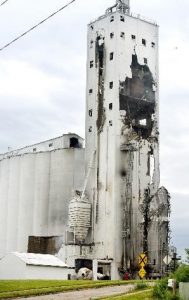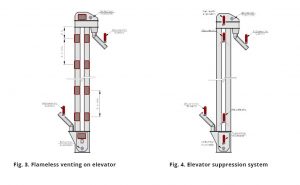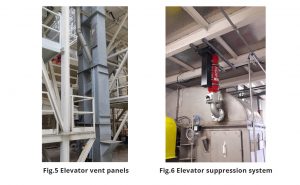20 years of experience at your service in protection
consulting and training in Explosive Atmospheres
Added to cart
There are no products in the basket
(DOWNLOAD E-BOOK VERSION HERE)
Bucket elevators represent one of the main equipment used for the transport of bulk solids in various types of installations: grain handling, breweries, feed mills, feed mills or the food industry, among others.
In addition to the above, elevators represent one of the main explosion risks in industries where flammable dusts are handled, mainly due to their high propensity to generate ignition sources of different origin.
This is why it is really important to carry out a correct assessment of explosion risks in installations that use this type of equipment, with the aim of reducing the probability of an explosion occurring, and if it does occur, that its consequences are minimal, avoiding material and human damage.

Fig.1 Explosion of bucket elevator (ref. Https//siouxcityjournal.com)
Explosion risk assessment
A proper explosion risk assessment must include at least the following points:
Classification of potentially explosive areas in bucket elevators
It is common to consider the equipment as an indoor area due to its high operating speed and high probability of continuous generation of dust clouds in flammable concentration but also due to the possibility of accumulation of dust layers adhering to the walls that may become suspended.
Effective ignition sources:
Sources of ignition produced by the hoist itself, such as:

Fig.2 Hot bearing surfaces (ref. https://bulkhandlingtoday.co.za)
2. Ignition sources introduced from other equipment which is interconnected, e.g. hot particles or explosions in other equipment as well as ignition sources produced by electrical equipment outside the lift.
3. External ignition sources due to maintenance, welding, cutting (hot work), smoking in the installation or deflagrations from other equipment. Such ignition sources are prevented by organisational measures.
4. Ignition sources produced by the product to be transported itself, e.g. due to self-combustion of dust accumulations inside the lift.
Recommended prevention and protection measures
In view of the possible presence of explosive atmospheres on an almost continuous basis and the variety of ignition sources that can be effective, the probability of an explosion occurring in an elevator is high and its consequences can be catastrophic for installations and persons.This is why both explosion prevention and explosion protection measures are considered necessary in this equipment, among which we must consider:
Prevention measures

Protection measures


Note: The implementation of protection systems on bucket elevators should follow a recognised standard or guide (e.g. technical report CEN/TR 16829, VDI 2263 or NFPA 61).
20 years of experience at your service in protection
consulting and training in Explosive Atmospheres
Personalized assistance in more than 30 countries.
Our customer service works to offer you the best solution.
Shipping. For more information here
Worldwide shipping.
Insurance included and return guarantee
Ask our sales team without obligation.
News on your company's protection
Be the first to know when new products are launched and get significant discounts
